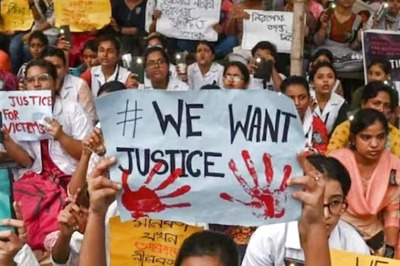
views
India has witnessed a sharp spike in Covid-19 cases in recent days with several cases being linked to the Tablighi Jamaat congregation in Delhi’s Nizamuddin. As of Thursday morning, 389 people linked to the religious conference were found positive for the novel coronavirus. The event was attended by several foreigners who later dispersed across India.
News18 takes a look at the number foreigners engaged in Tabilighi Jamaat works in India and examines India's screening strategy prior to the event.
How many foreigners attended the event and from how many nations?
An estimated 2,000 foreigners from 70 countries were in India in connection with the Tablighi Jamaat as per an internal advisory of the Ministry of Home Affairs (MHA) which was accessed by CNN-News18. Majority of these foreigners belong to Bangladesh (493), followed by Indonesia (472), Malaysia (150) and Thailand (142). People also came from Kyrgyzstan, Belgium, Tunisia, Sri Lanka and Myanmar. Their period of stay in India is up to six months, as per the MHA advisory and they were in India on a tourist visa.
How many of them travelled for Tablighi Jamaat activities outside Delhi?
According to a note released by the MHA on March 31, Tablighi activists, both foreigners as well Indians, carried out Tabligh works (Chilla) across the country throughout the year. All such foreign nationals normally report their arrival at Alami Markaz Banglewali Mosque in Hazrat Nizamuddin in New Delhi. From there, they travel to different states for Chilla activities. As many as 824 foreigners had been, as on March 21, carrying out Chilla activities in various parts of the country, according to the home ministry.
These 824 foreigners were present across Andhra Pradesh, Tamil Nadu, Maharashtra, Haryana, Uttar Pradesh, Karnataka, West Bengal, Rajasthan Jharkhand, Madhya Pradesh, Odisha and Telangana.
What was India's screening strategy when the congregation met in Nizamuddin and prior to the event?
Questions have been raised as to why these foreigners were not screened or quarantined despite the Covid-19 outbreak in China and southeast Asian countries being widely reported. Specific information on when these Tablighi affiliates entered the country was not available with News18, but the Nizamuddin event was conducted between March 10 and 13 so the affiliates arrived in India before March 9.
In a note it released on March 31, the home ministry said the Bureau of Immigration has been sharing (since February 1) with state authorities details of all international arrivals from affected countries based on a self-declaration form. However, India began universal screening only from March 5.
What were the travel advisories issued by the central government?
India began issuing travel advisories from January 17 to alert Indians about the coronavirus risk. An analysis of all travel advisories issued and made public by the government showed that until February 26, nearly a month after the first Covid-19 case was detected in India, all advisories pertain only to China.
Also, until March 3, seven days before the Nizamuddin event, the government had not issued any travel advisory asking for screening of travellers (Indian and foreigners) coming from United Arab Emirates, Saudi Arabia, Indonesia, Thailand, Malaysia and EU countries other than Italy.
It is noteworthy because between February 27 and March 1, a Tablighi Jamaat event similar to the one in Delhi was conducted in Malaysia and the country saw a spike in cases following that event. The Indian government has not clarified if Indians and foreigners who may have been present at the Malaysian event also participated in the Delhi conference.
Between January 17 and January 25, all advisories merely alerted travellers going to China about the novel coronavirus and issued guidelines to be followed with regards to hygiene and maintaining distance. The first advisory asking Indians to refrain from going to China and mentioning quarantine for those returning from China was issued on February 5, six days after India's first Covid-19 case in Kerala.
On February 26, Indian citizens were further advised to refrain from non-essential travel to Singapore, South Korea, Iran and Italy. People coming from South Korea, Iran and Italy or those with a history of travel to these countries may be quarantined for 14 days on arrival to India, the advisory had said. Japan was added to this list in an advisory issued on March 2.
On March 3, the government suspended, with immediate effect, visas granted to nationals of Italy, Iran, South Korea, Japan and issued on or before March 3. On March 10, travellers coming from France, Spain and Germany were put on airport screening lists and an advisory asked them to self-quarantine.
It was only on March 16 that the government extended quarantine advisory to travellers coming from UAE, Qatar, Oman, and Kuwait and on March 17, travel of passengers from Afghanistan, Philippines and Malaysia to India was prohibited with immediate effect.
On March 19, all international flights were grounded.
What is the importance of containment (screening) and mitigation (quarantine)?
India adopted screening, quarantine and lockdown measures to break what ICMR scientists called “the chain of transmission” of the novel coronavirus. However, in January and February when the outbreak had not affected India in large numbers, the focus of India’s strategy was on closing borders and airport screening. Indian officials have said in the past that the advisories and screening measures were based on how the epicentre of the Covid-19 outbreak was shifting, from China to Iran and then to Italy.
An Indian Council of Medical Research (ICMR) paper had found that if symptomatic arrivals alone were screened, the epidemic could be delayed only by a maximum of 47 days. The paper had concluded that quarantine & isolation was the best bet.
“An optimistic scenario to reduce cases was to quarantine 50% of symptomatic cases within three days of developing symptoms. “This would reduce the cumulative incidence by 62% and the peak prevalence by 89%,” the paper said. As a consequence, “the intervention has the effect of ‘flattening’ the epidemic curve” and will distribute the cases over a longer duration and reduce cumulative incidence by 62 per cent, the paper added.
With inputs from Arunima, CNN-News18




















Comments
0 comment